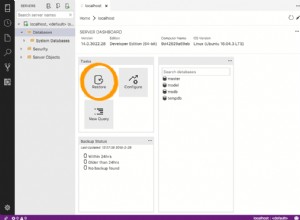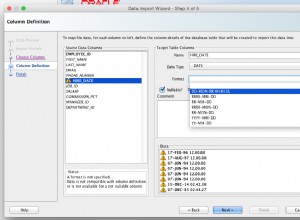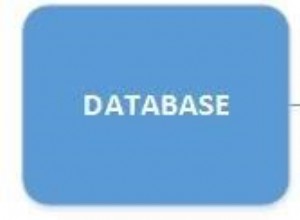Identificare valori non consecutivi è sempre un po' complicato e coinvolge diverse sottoquery nidificate (almeno non riesco a trovare una soluzione migliore).
Il primo passo è identificare i valori non consecutivi per l'anno:
Fase 1) Identifica i valori non consecutivi
select company,
profession,
year,
case
when row_number() over (partition by company, profession order by year) = 1 or
year - lag(year,1,year) over (partition by company, profession order by year) > 1 then 1
else 0
end as group_cnt
from qualification
Questo restituisce il seguente risultato:
company | profession | year | group_cnt ---------+------------+------+----------- Google | Programmer | 2000 | 1 Google | Sales | 2000 | 1 Google | Sales | 2001 | 0 Google | Sales | 2002 | 0 Google | Sales | 2004 | 1 Mozilla | Sales | 2002 | 1
Ora con il valore group_cnt possiamo creare "ID gruppo" per ogni gruppo che ha anni consecutivi:
Passaggio 2) Definisci gli ID gruppo
select company,
profession,
year,
sum(group_cnt) over (order by company, profession, year) as group_nr
from (
select company,
profession,
year,
case
when row_number() over (partition by company, profession order by year) = 1 or
year - lag(year,1,year) over (partition by company, profession order by year) > 1 then 1
else 0
end as group_cnt
from qualification
) t1
Questo restituisce il seguente risultato:
company | profession | year | group_nr ---------+------------+------+---------- Google | Programmer | 2000 | 1 Google | Sales | 2000 | 2 Google | Sales | 2001 | 2 Google | Sales | 2002 | 2 Google | Sales | 2004 | 3 Mozilla | Sales | 2002 | 4 (6 rows)
Come puoi vedere ogni "gruppo" ha il suo gruppo_nr e questo possiamo finalmente usarlo per aggregare aggiungendo ancora un'altra tabella derivata:
Fase 3) Query finale
select company,
profession,
array_agg(year) as years
from (
select company,
profession,
year,
sum(group_cnt) over (order by company, profession, year) as group_nr
from (
select company,
profession,
year,
case
when row_number() over (partition by company, profession order by year) = 1 or
year - lag(year,1,year) over (partition by company, profession order by year) > 1 then 1
else 0
end as group_cnt
from qualification
) t1
) t2
group by company, profession, group_nr
order by company, profession, group_nr
Questo restituisce il seguente risultato:
company | profession | years
---------+------------+------------------
Google | Programmer | {2000}
Google | Sales | {2000,2001,2002}
Google | Sales | {2004}
Mozilla | Sales | {2002}
(4 rows)
Che è esattamente quello che volevi, se non sbaglio.




